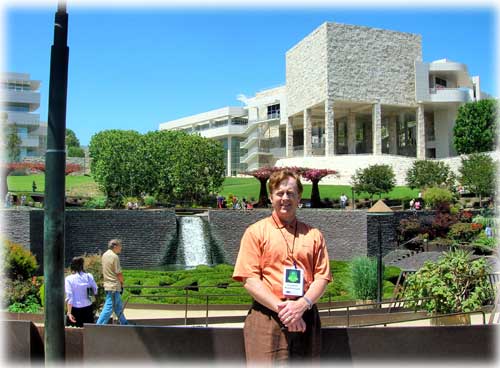 by Preston MacDougall July 10, 2005
There may also be a time lag, such as when we first saw the grave images of the Twin Towers going from seemingly defying the laws of gravity, to shockingly verifying them. Less certain is the link between seeing and understanding. This is why we need teachers. Unfortunately, just as a caterpillar can turn into a moth, somehow, over the last few generations, the teaching profession has morphed from a respected calling into a thankless job. The reasons for this are complex and I don't pretend to know all of them (although I can think of a few biggies). I have also over-generalized the situation - some teachers are butterflies.  Photo courtesy Preston MacDoughall
Los Angeles has just hosted a cavalry charge of a sort. The Getty Center was the sight of the second Image and Meaning Workshop (the first was at MIT), where an eclectic group of scientists, artists, writers and editors mixed and mingled, with a critical eye on all manner of images used to communicate science. With a central goal to expand the ways in which participants think about visually communicating scientific information, whether it is conceptual or hard-won data, these conferences are the brainchild of MIT photographer, research scientist and match-maker Felice Frankel. The idea is to pair people that have novel imaging ideas with others who are looking to tease ideas out of massive data sets, or perhaps just more clearly communicate new and abstract ideas. In addition to the registration fee, conferees were required to ante-up with a "challenge in visualization" from their own professional niche. My wish was for a simple way to convey the multiple layers of chemically interesting features that make relatively simple molecules capable of richly varying behavior. (The conventional image of a molecule as glossy little balls, connected with rigid-looking sticks, rates low on the meaning scale.) As often happens with complex systems, unexpected connections emerge, and these may offer bridges from problems to solutions. For instance, the person sitting next to me during a break-out session passed around a multi-layered map of Manhattan that his company had developed. The map was precision-crafted, using highly specialized plastics, but the basic idea was the key to a toy that I had played with long ago, and which came from the bottom of a box of Cracker Jack. Three or more high-resolution renderings can be viewed in quick succession by simply changing the viewing angle. Surprise! In a memorable line during one of the panel discussions, Peter Atkins, a chemist from the University of Oxford, qualified the popular saying regarding the default value of a picture. He said "Some pictures need a thousand words to explain their meaning." In that case, you could say that they have no net value, figuratively speaking. What does this have to do with education? Very simply, not every student in a biology class is patient enough to watch a chrysalis mature into a butterfly. And no chemistry class will ever be able to watch two atoms form a chemical bond. Teachers rely on images of various formats to substitute for actual reality. As Professor Atkins also pointed out "Teaching is a bridge between what is perceived and what is imagined." To help teachers be better bridges, the design of the image is critical. The design and use of images of all types are within the scope of the Image and Meaning initiative, from photographs, to movies, to computer simulations. Cartoonists were penciled in as well. In a bow to the world in which we live, computer games were discussed seriously, pros and cons. Interestingly, by my count, the pros out-numbered the cons. I am not sure when or where the third Image and Meaning Workshop will be held, but I am confident that many pleasant surprises will be in store for its visually adventurous participants. Details of past and, eventually, future events can be found online at web.mit.edu/i-m . Who knows, if you go, you might be treated to the Super Mario Brothers' debut in Chemintendo.
|